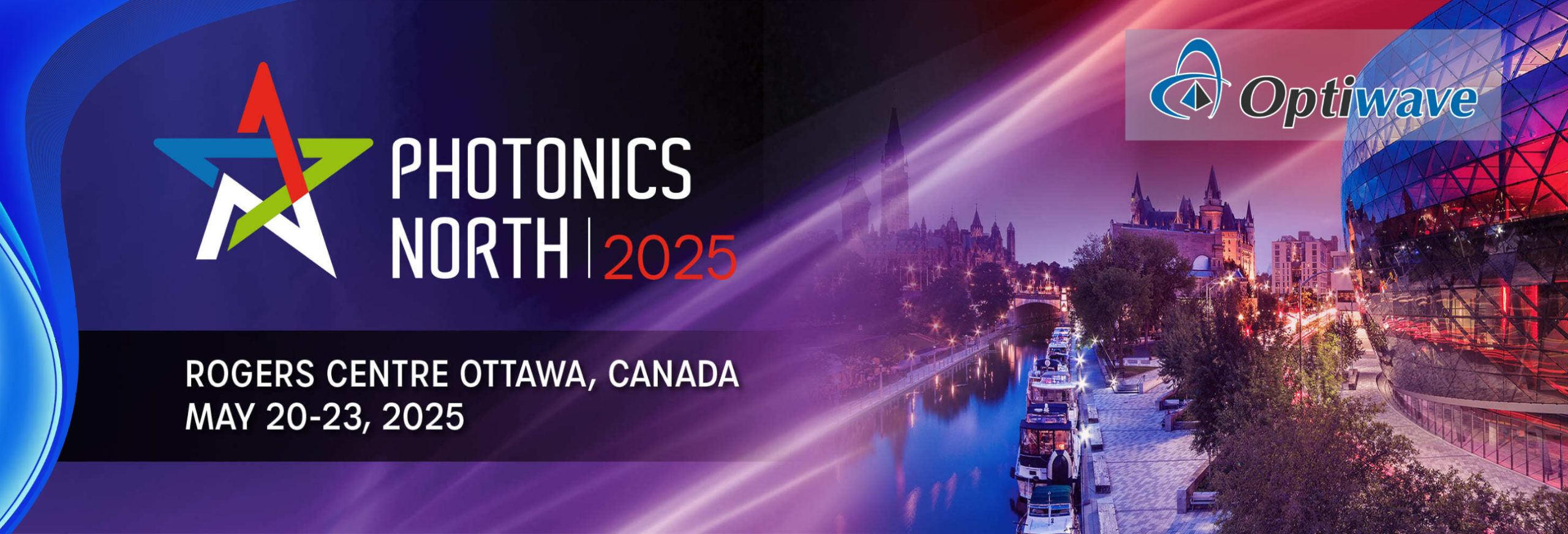
May 20-23, 2025
Rogers Centre, Ottawa, Ontario, Canada
We’re excited to announce that Optiwave will be a proud participant at Photonics North 2025 (May 20–23, Ottawa, Canada), showcasing groundbreaking research and fostering collaboration in photonic innovation. With five technical papers—including collaborations with McMaster University, the National Research Council (NRC), and the University of Ottawa—we’re pushing the boundaries of optical technologies.

Explore Optiwave’s cutting-edge work across these key sessions:
- Compact Subwavelength Grating-Assisted TFLN Wavelength Demultiplexer with Ultra-Low Loss
Date: Tuesday, May 20 | Time: 2:30 PM
Brief: We present an ultra-low-loss, broadband two-channel wavelength demultiplexer designed on a thin-film lithium niobate (TFLN) platform. The proposed design leverages subwavelength grating (SWG)-assisted directional coupling on both sides of the SWG to achieve efficient wavelength splitting at 780 nm and 1550 nm. This approach not only minimizes the device footprint and significantly reduces insertion losses but also improves the extinction ratio. The optimized demultiplexer, with a compact length of 56 µm, exhibits exceptionally low insertion losses of 0.36 dB and 0.22 dB, high extinction ratios of 33 dB and 16 dB for 780 nm and 1550 nm, respectively, and 0.5-dB bandwidths exceeding 70 nm for both wavelengths. - Free space NIR optical communications link model validation using scintillation and link performance characterization
Date: Wednesday, May 21 | Time: 8:15 AM
Optical free space communication can enable high bandwidth communication links where the use of optical fiber is not possible or impractical. However, the performance modeling and scintillation of such links, which determine link availability and capacity under varying meteorological conditions is challenging to predict for real systems. In this work, we outline our goal towards the development, characterization, and validation of free-space optical communication system modeling in Optiwave OptiSystem software using the NRC-ARTEMIS optical ground station under varying environmental conditions such as temperature, wind, and weather and their correlation to scintillation, attenuation and bit error rates (BER). - Predictive model for attenuation of free-space laser power and data transmission based on real time weather conditions
Date: Friday, May 23 | Time: 3:45 PM
Space-to-ground laser data and power beaming is a promising technique to simultaneously communicate and provide electricity to remote areas without direct access to wired connections. However, this transmission method is often subject to important losses in the atmosphere. To understand, anticipate and mitigate these attenuations, our research team is developing ATMOS LINK, a model that predicts the beam absorption based on real-time ambient parameters and weather conditions. - Flexible System-Level Characterization of Photonic Integrated Circuits in OptiSystem
Date: Tuesday, May 20 | Time: 4:40 PM
Photonic integrated circuits (PICs) are the key technology for reducing the footprint, energy consumption and lower costs of optoelectronic modules. Characterizing these PICs is necessary not only at the chip level but also at the system level. OptiSystem software plays a key role enabling designers to evaluate their PIC designs. Integrating IPKISS software with OptiSystem supports a full optical communication system characterization of PICs. An automated characterization of a cross-connect switch and a ring resonator demultiplexer PICs conducted in OptiSystem. Atieh et. al._Invited - Electrically Tunable Micro-ring and Micro-Racetrack Resonators Using Gold Layer on Thin Film Lithium Niobate
Date: Wednesday, May 21 | Time: 6:00 PM
We present a theoretical study of electrically tunable ring resonators and racetrack structures on the thin-film lithium niobate (TFLN) platform. By employing a gold layer on top of the waveguide, we achieve tunability, enabling the racetrack ring’s response to be shifted for selective filtering or to be overlapped with the ring resonator’s response for various applications. We also investigate the Q-factor for several racetrack lengths, considering different propagation losses.
Why Connect With Us?
- See OptiSystem in Action: Discover how our software enables breakthroughs in optical design, from PICs to free-space communications.
- Collaborate: Discuss partnerships with our team and academic allies (McMaster, NRC, uOttawa).
- Solve Challenges: Explore solutions for signal integrity, atmospheric attenuation, and system-level photonic integration.

Interested in our research, tools, or collaborations?
Meet Ahmad Atieh, VP, Optical Systems at Optiwave:




